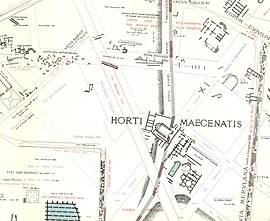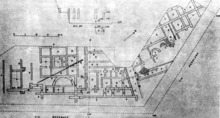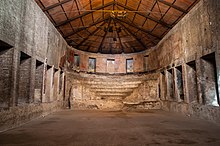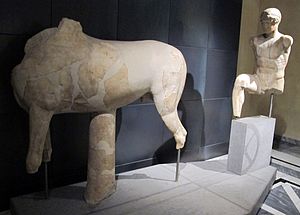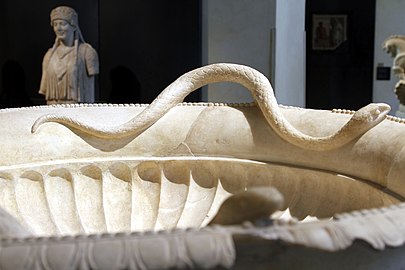
Gaius Cilnius Maecenas was a friend and political advisor to Octavian. He was also an important patron for the new generation of Augustan poets, including both Horace and Virgil. During the reign of Augustus, Maecenas served as a quasi-culture minister to the Roman emperor but in spite of his wealth and power he chose not to enter the Senate, remaining of equestrian rank.

The Esquiline Hill is one of the Seven Hills of Rome. Its southernmost cusp is the Oppius.

The Servian Wall is an ancient Roman defensive barrier constructed around the city of Rome in the early 4th century BC. The wall was built of volcanic tuff and was up to 10 m (33 ft) in height in places, 3.6 m (12 ft) wide at its base, 11 km (6.8 mi) long, and is believed to have had 16 main gates, of which only one or two have survived, and enclosed a total area of 246 hectares. In the 3rd century AD it was superseded by the construction of the larger Aurelian Walls as the city of Rome grew beyond the boundary of the Servian Wall.
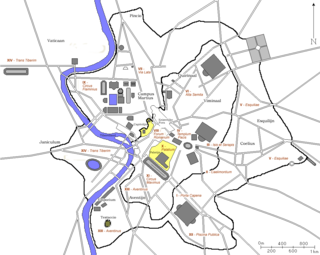
In 7 BC, Augustus divided the city of Rome into 14 administrative regions. These replaced the four regiones—or "quarters"—traditionally attributed to Servius Tullius, sixth king of Rome. They were further divided into official neighborhoods.
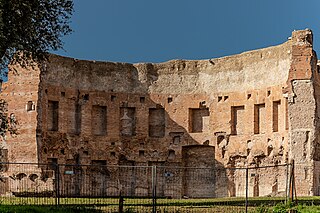
The Baths of Trajan were a massive thermae, a bathing and leisure complex, built in ancient Rome and dedicated under Trajan during the kalendae of July 109, shortly after the Aqua Traiana was dedicated.

Esquilino is the 15th rione, or administrative division, of Rome, identified by the initials R. XV, and is Located within the Municipio I. It is named after the Esquiline Hill, one of the Seven Hills of Rome.

The study of Roman sculpture is complicated by its relation to Greek sculpture. Many examples of even the most famous Greek sculptures, such as the Apollo Belvedere and Barberini Faun, are known only from Roman Imperial or Hellenistic "copies". At one time, this imitation was taken by art historians as indicating a narrowness of the Roman artistic imagination, but, in the late 20th century, Roman art began to be reevaluated on its own terms: some impressions of the nature of Greek sculpture may in fact be based on Roman artistry.
Campus Esquilinus was an area on the Esquiline Hill in ancient Rome. It was the site of many extravagant buildings as well as baths and gardens. The Campus Esquilinus was also the site of executions and burials, though it was eventually turned into a park by Augustus.

The Gardens of Sallust was an ancient Roman estate including a landscaped pleasure garden developed by the historian Sallust in the 1st century BC. It occupied a large area in the northeastern sector of Rome, in what would become Region VI, between the Pincian and Quirinal hills, near the Via Salaria and later Porta Salaria. The modern rione is now known as Sallustiano.
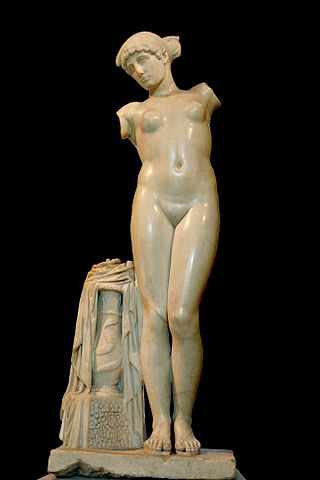
The Esquiline Venus, depicting the goddess Venus, is a smaller-than-life-size Roman nude marble sculpture of a female in sandals and a diadem headdress. It is widely viewed as a 1st-century AD Roman copy of a Greek original from the 1st century BC. It is also a possible depiction of the Ptolemaic ruler Cleopatra VII.

The Arch of Gallienus is a name given to the Porta Esquilina, an ancient Roman arch in the Servian Wall of Rome. It was here that the ancient Roman roads Via Labicana and Via Tiburtina started.

The Porta Esquilina was a gate in the Servian Wall, of which the Arch of Gallienus is extant today. Tradition dates it back to the 6th century BC, when the Servian Wall was said to have been built by the Roman king Servius Tullius. However modern scholarship and evidence from archaeology indicate a date in the fourth century BC. The archway of the gate was rededicated in 262 as the Arch of Gallienus.
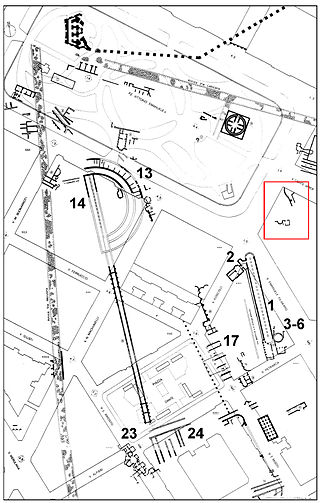
The Horti Lamiani was a luxurious complex consisting of an ancient Roman villa with large gardens and outdoor rooms. It was located on the Esquiline Hill in Rome, in the area around the present Piazza Vittorio Emanuele. The horti were created by the consul Lucius Aelius Lamia, a friend of Emperor Tiberius, and they soon became imperial property. They are of exceptional historical-topographical importance. Along with other ancient Roman horti on the Quirinal, Viminal and Esquiline hills, they were discovered during the construction work for the expansion of Rome at the end of 1800s.

The Oppian Hill is the southern spur of the Esquiline Hill, one of the Seven hills of Rome, Italy. It is separated from the Cispius on the north by the valley of the Suburra, and from the Caelian Hill on the south by the valley of the Colosseum. The Oppius and the Cispius together form the Esquiline plateau just inside the line of the Servian Wall.
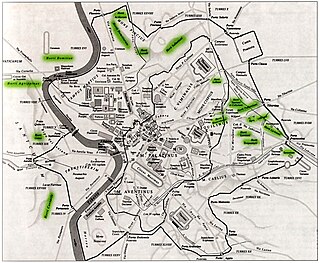
The Horti Liciniani was a luxurious complex of an ancient Roman villa with large gardens and outdoor rooms originally belonging to the gens Licinia. It was located in Rome on the Esquiline Hill between via Labicana and via Prenestina, close to the Aurelian walls. They bordered the Horti Tauriani to the north and the Horti Pallantiani and Horti Epaphroditiani to the west.
Aconia Fabia Paulina was an aristocratic Roman woman, the daughter of Aconius Catullinus Philomatius, who was consul in 349. In 344 she married Vettius Agorius Praetextatus. Paulina was initiated into the Eleusinian mysteries and was a priestess of Hecate and of the Magna Mater.

The Porta Querquetulana or Querquetularia was a gateway in the Servian Wall, named after the sacred grove of the Querquetulanae adjacent to and just within it. The grove appears not to have still existed in the latter 1st century BC.

The Regio VII Via Lata is the seventh regio of imperial Rome, under Augustus's administrative reform. Regio VII took its name from the wide urban street the Via Lata. It was the urban section of the Via Flaminia, which ran between the Servian walls and the Aurelian Walls, and corresponds to the modern Via del Corso. The regio contained part of the Campus Martius on the east of the street plus the Collis Hortulorum, the Pincian Hill.
